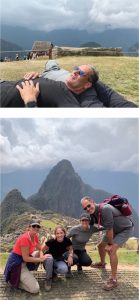Sleeping at Machu Picchu: Engagement Mistakes to Avoid
Feature Story – By Jill Donahue
Rather than bringing the mysteries of the Inca people to life, the guide lulled us to sleep.
 As life sciences training professionals, we tend to find inspiration in “unusual” places – sometimes even in magnificent places. That is certainly true from my family’s recent excursion to Machu Picchu.
As life sciences training professionals, we tend to find inspiration in “unusual” places – sometimes even in magnificent places. That is certainly true from my family’s recent excursion to Machu Picchu.
Last summer, my husband and I were excited to bring history to life for our 12-and 16-year-old daughters. It was a no-brainer to hire a private guide for our journey. But rather than bringing the mysteries of the Inca people to life, the guide lulled us to sleep!
I watched as my girls and husband quickly lost interest, then eventually lay on the
ground and finally fell asleep! All the while, our guide kept talking. I, in the
meantime, started counting her mistakes and revising in my mind her presentation
strategy.
 By my count, she made the three biggest mistakes I commonly see when helping life sciences speakers and trainers be more engaging. Read on to see if you make them too.
By my count, she made the three biggest mistakes I commonly see when helping life sciences speakers and trainers be more engaging. Read on to see if you make them too.
- Not Knowing Your Audience – She didn’t ask our names or our interests. We felt like she didn’t know us at all. As a professional speaker, I know that the time I take prior to a talk to get to know the audience pays off in dividends with the increased connection that is created.
How can you avoid this as a life sciences trainer? Ideally, you will have learned about your audience through a needs assessment to help you prepare. My favorite question? “By the end of this workshop on ABC, you will be thrilled if you … what?”
 If a needs assessment isn’t possible, at least show up a few minutes early. Shake hands with the participants, look them in the eyes, show interest in where they are from and why they are there.
If a needs assessment isn’t possible, at least show up a few minutes early. Shake hands with the participants, look them in the eyes, show interest in where they are from and why they are there.
As a bare minimum, if neither of the above is possible, ask the audience at the beginning of your session what they want to know about the specific topic – even if only through a multiple-choice question. That will help you know what to emphasize and what to skip or skim over. Build their trust that you are there to help them.
- Not open to questions – Early on in the guide’s diatribe I asked a question. She said “Just wait. I will get to that later.” Telling is not engaging! I watched my girls attempt to interject with questions, but they were ignored. When she finally finished talking and asked us to follow her to the next stop, I asked her to wait because the girls had some questions. I turned to them, but they stared back blankly. Of course, they had forgotten their questions. Relevancy is key.
As we walked on, I quietly suggested to her that she may get more engagement from them if she were open to and even encouraged them to ask questions.
“But I have so many details to get through, I don’t want to forget them!” she justified.
This reminded me of some speakers. I can’t tell you how many times people justify their boring sessions by saying, “I had to get through the information.”
How can you avoid this as a life sciences trainer? If it looks or sounds like a handout, make it one! Remind yourself: What good is saying all the details if no one is listening? Wouldn’t it be better to share just a portion to an audience that is listening? Then provide the rest in written/visual format to take home? Isn’t it be better to do a little bit well rather than a lot poorly?
Encourage questions. Avoid the famous “I will take questions at the end.” It will be far more engaging for both you and the audience to be interactive. By knowing what they are thinking, you will know what to emphasize or omit.
- Not making us think – She surely was knowledgeable. Indeed, she was encyclopedic, listing the numerous historical names, events and the dates. She just kept presenting fact after fact. Again, this reminded me of many life sciences talks. I started imagining how much better it would be if she would just:
- Ask a few questions: “What do you notice is different in this wall versus the brick walls we build now?”
- Tell us some stories: “Imagine, it hasn’t rained for weeks. The crops need water fast. There is a beautiful young Incan girl, about your age, and the elders think perhaps if they sacrificed her to the gods…”
- Ask for our opinions: “Those are the three theories for why the Incas left Machu Picchu. Which one makes most sense to you … why?”
How can you avoid this as a life sciences trainer? Remember, telling is not engaging. Build questions into your session. If the audience is too large to create the conversation, answer the question yourself, or offer options and have them raise their hands when they hear the correct option.
Make their minds think! Share stories. The easiest stories in healthcare are, of course, patient stories or cases. Ask the audience to discuss in small groups what they would do or debate the options in front of them.
 Conclusion
Conclusion
Bottom line, I felt like our tour guide had her agenda top of mind. She had a script to get through. If you ever feel like you are just getting through slides, stop. The single most important thing you can do as a life sciences trainer is remember that you are there to help them help doctors help patients.
Focus on their need to help doctors and patients, not your need to “get through” the information. Serve your audience, not by reciting fact after fact, but by applying the ART of delivering an engaging presentation:
- A – Know your Audience.
- R – Respond to (even encourage) questions.
- T – Make them Think (by using questions, stories and discussion).
And finally, remember that your audience will never rise above your level of enthusiasm. Do the above with enthusiasm! Love your topic and show it! Be guided by your purpose to improve patient outcomes.
Jill Donahue is principal for Excellerate and co-founder of The Aurora Project. Email Jill at Jill.Donahue@excellerate.ca.








